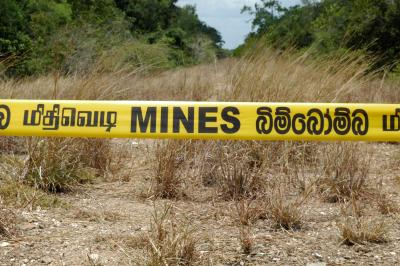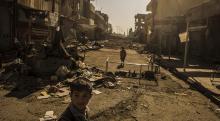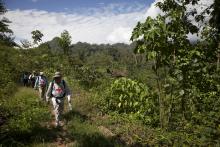Case prepared by David Köller and Angèle Jeangeorge, LL.M. students at the Kalshoven-Gieskes Forum IHL Clinic, Leiden University, under the supervision of Professor Robert Heinsch as well as Sofia Poulopoulou and Christine Tremblay (PhD researchers/research assistants), Kalshoven-Gieskes Forum, Leiden University.
A. MINE CLEARANCE AND THE DEGREE OF CONTAMINATION AS OF 2017
[…]
Contamination
Sri Lanka is extensively contaminated by mines and ERW [explosive remnants of war]. Most contamination is in the north, the focus of three decades of armed conflict between the government and the Liberation Tigers of Tamil Eelam (LTTE), which ended in May 2009. The estimate of mine/ERW contamination as of February 2017 was just over 26.3km2, a decrease from the nearly 68.4km2 in June 2015. […]
Mine clearance in 2016
| Operator |
Areas cleared |
Area cleared (m²) |
AP mines destroyed |
AV mines destroyed |
UXO destroyed |
| DASH |
N/R |
770,110 |
12,630 |
65 |
875 |
| MAG |
29 |
453,575 |
10,280 |
2 |
430 |
| HALO |
29 |
802,168 |
16,192 |
44 |
1,214 |
| SHARP |
N/R |
27,264 |
69 |
0 |
5 |
| SLA |
N/R |
296,304 |
20,133 |
6 |
383 |
| Total |
58 |
2,349,421 |
59,304 |
117 |
2,907 |
[…]
B. TOWARDS A MINE-FREE NATION
Demining Progress
[…]
Currently, nine organizations are demining in Sri Lanka’s northern and eastern parts: the Sri Lankan Army’s Humanitarian Demining Unit, The HALO Trust, Danish Demining Group, Fondation Suisse de Déminage, MAG (Mines Advisory Group), Sarvatra, Horizon, Milinda Moragoda Institute for Peoples’ Empowerment and Delvon Assistance for Social Harmony. […] Clearing the most affected areas by 2020 to allow people to begin rebuilding their livelihoods from the land is SLNMAC’s [Sri Lanka National Mine Action Center] current goal. Factoring in the annual clearance average since 2002 of 171 square kilometers (66 square miles), however, indicates that the required time to clear the remaining areas would be nearly 15 years.
[…]
MRE [Mine Risk Education] Campaigns
Sri Lanka’s Ministry of Education has taken a broader approach to MRE with UNICEF’s support. One important step in this approach was educating the educators; principals and selected teachers from all northern and eastern schools have received MRE training. Numerous schools in the most affected areas are taking a creative approach to MRE: Educational messages are displayed through wall paintings; activities such as dramas and art competitions are held; and messages printed on stationery, schoolbags and water bottles are distributed. To ensure MRE’s sustainability, the MoE will include MRE in next year’s school curriculum as well. The MoE is not the only entity delivering MRE; national NGOs in 2009 reached more than 250,000 Technical Working Group participants. […] MRE recipients demonstrated mine-safe behavior by reporting 672 suspected dangerous objects and hazardous areas during 2010.
[…]
The SL Police Service is currently being trained to deliver MRE. Using the SL Police Service to deliver MRE has some advantages: It employs bilingual police officers (there is a widespread police presence throughout the country) and it can easily mobilize its people and hold officers accountable for achieving maximum results.
[…]
C. HUMANITARIAN MINE ACTION TRAINING MISSION TO SRI LANKA
[…]
To assess how the United States could most effectively aid the Sri Lankan military with its humanitarian-demining efforts in northern Sri Lanka, the Humanitarian Mine Action Team, a group of six U.S. military and civilian demining professionals from the Office of the Secretary of Defense, U.S. Pacific Command, Special Operations Command Pacific, and U.S. Army Pacific Command, visited the country in June 2009, meeting with government officials, military members and nongovernmental organization representatives. In response to the crisis, the U.S. Department of State also announced funding of US$6.6 million to support demining in the north.
[…]
From 24 June through 1 August, the HMA [Humanitarian Mine Action] team conducted a Requirements Determination Site Survey to finalize the training’s logistical planning, such as determining the curriculum components, trainees, and necessary equipment and how it would be obtained.
[…]
Under the order and approval of USARPAC [U.S. Army Pacific], the HMA team conducted HMA management, including a humanitarian demining train-the-trainer program for 26 Sri Lankan Army officers in the Sri Lanka School of Military Engineering, and provided demining equipment valued at more than $90,000 to the Army for its northern efforts.
[…]
The experience level of the trainees ranged from skilled HD SLA [Sri Lankan Army’s humanitarian demining] commanders to “future commanders unfamiliar with the humanitarian-demining process but experienced in the military engineer field.” Training was conducted in accordance with International Mine Action Standards.
[…]
D. TAMIL TIGER FIGHTERS TRAINED CIVILIANS TO REMOVE LANDMINES IN 2003
Sri Lanka's Tamil Tiger rebels are now training women to help remove landmines following the 20-year ethnic conflict.
[…]
The Tamil Rehabilitation Organisation, a non-governmental outfit working for the resettlement of displaced Tamils in the Wanni region, has set up 15 teams of de-miners under the Humanitarian Demining Unit. But these are not sufficient to clear the vast area, which are [sic] out of bounds. To overcome the shortage of manpower, the LTTE's demining unit has recruited women to join its ranks. These women are undergoing rigorous training in simulated minefields. Unlike the male deminers, who were trained by foreign experts, local experts are training these women. Samthan, a Demining Trainer, said: "The training will be for a month, after which these women will join the demining team. But then, they will continue to receive on the job training. The experience they will get while working in real minefields will help them learn more." According to rough estimates, there are over a million and a half landmines laid in the region controlled by the LTTE. At the current pace of demining, it would take more than a year for the Humanitarian Demining Unit to clear all of them. As they do not have any information about the location of landmines laid by the government troops, their task is proving difficult.
[…]
Discussion
I. Classification of the Situation and Applicable Law
1. How would you classify the situation in Sri Lanka that took place between Sri Lanka and the LTTE until 2009? What additional information would you have required to make such a determination? Who were the parties to the armed conflict? (
GC I-IV, Art. 3)
II. Demining Action
4. Do non-state armed groups that are parties to the conflict have demining obligations under IHL? What is the legal basis for the obligations of the LTTE with regard to demining? (
CIHL, Rule 83;
CCW Amended Protocol II , Art.10)
5. What is the role of the third States and international or regional organizations in the mine clearance process? Do third States have a duty to co-operate? In your opinion, did the broad range of actors involved facilitate the fulfilment of the State’s obligations towards demining under IHL? (
CCW Protocol II, Article 9)
III. Elements Contributing to Respect for IHL
6. In your opinion, what may be the incentives of a non-state armed groups like the LTTE to engage in mine-clearance efforts? Can mine clearance have an impact on the perception of the parties by the civilian population?
7. Apart from humanitarian considerations, why do you think third States are supporting the parties to the conflict in their mine-clearance efforts? Do you think that mine-clearance contributes to peace and stability in the country and in the region?
8. In your opinion, what are the benefits of the mine risk education offered to the communities mostly affected by landmines? What, if any, influence did this training have on the ongoing demining process and the fulfilment of the obligations in relation to demining under IHL?






